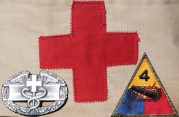In different documents, especially in Company Morning Reports, we often find different numbers connected to the men. First, there is of course an Army Serial Number identifying a person.
But there is often a second number attached to a name. These numbers, called SSN (Specification Serial Number) are the numerical codes assigned to a MOS (Military Occupational Specialty).
Simply put, these numbered codes describe the job an individual performed in the Army. SSN for enlisted men are three-digit codes, for (warrant) officers they are four-digit codes. For a list of the SSN/MOS codes that are mentioned within the documents of this research, click here: MOS List used.
The use of SSN/MOS
According to TM 12-427 Classification of Military Occupational Specalties of Enlisted Men- Introduction (the Technical Manual that describes this system for the enlisted men), the men were given these classification codes based on their training, experience, and abilities. So all men with the same SSN should be able to perform the same duty.
By using this classification the Army could try to make the best use of a men’s capabilities. It could create TO&E (Table of Organization and Equipment) for units by creating lists of the type and number of personnel needed in such units.
It would also make the requisition and assignment of replacements to units easier.
Finally, it could be useful during the demobilization and return to civilian life by showing what training and experience a soldier had during his service.
How I used the SSN/MOS for my research
For my research, I used the SSN/MOS to gain a better understanding of the TO&Es. It made it possible for me to assign specific names to specific SSN/MOS mentioned within the TO&Es. The results of these efforts can be seen in the Personnel Documents.
Within these documents, only by using the SSN/MOS can truly see that some “jobs” had a frighteningly high casualty rate.
We can also start to make sense of the changes in MOS for a person, for example, an experienced Medical Technician might be promoted to Medical NCO when one was needed in a unit. This would show as a chance in MOS from 409 to 673.
So investing a bit of time to understand these numbers can be very helpful.
The Replacement System
On paper this system would make sure that the units received the replacements they needed, ready to perform the duty that was required of them. It was however dependent on a correct guesstimate by the Army on how many men with a certain MOS would be needed on a certain moment, at a certain Replacement Depot. Unfortunately, this guesstimate was often far from correct.
Studying the SSN/MOS of the replacements assigned to the 4th AD shows us one of the weaknesses in this often criticized system. The men that were needed were often of poor training or were simply not there!
As the Division Surgeon’s Journal in the entry of August 8th 1944 shows:
“We received 16 replacements. They were of poor quality showing a decided lack of training”.
And in the Division Surgeon’s Journal of October 12th 1944 it reads:
“Medical Aid Men Replacements remain a problem. Approximately 40% of the so-called aid men which we receive are cooks, truck drivers and administrative personnel who have had no previous training whatsoever in first aid. This has been brought to the attention of higher HQ repeatedly. During the rest period the 46th AMB conducted a school for all medical personnel replacements. The general caliber of the medical replacements can be judged by the fact that up to date 85% of the combat exhaustion cases in aid men are replacements”.
As we can see, when casualties with a certain MOS were higher than anticipated the number of replacements within the Replacement Depots was often woefully inadequate. The Army then had no other alternative than to send men to do jobs they no (almost) no training for.
This explains the men in the 4th AD personnel documents who have SSN/MOS codes that are not part of the TO&E. We can find some Pharmacists (149), Hospital Orderlies (303), and even an Athletic Instructor (283) to name a few.
Fixing the problem, 4th AD style
The 4th AD medical personnel tried to remedy this situation to the best of their ability by giving these men much-needed training whenever the combat situation allowed it. The Division Surgeon even made a detailed training schedule (Training program for Replacements) for all replacements so they could do their jobs with at least some first aid training.
One other way the 4th AD tried to solve this problem was to continuously check the hospitals to see if their casualties were able to return to duty. They would arrange for these men to be picked up and brought back to their units before they would be sent to the Replacement Depots for reassignment (as was customary).
This way the division tried to retain as many well-trained men as possible with the units they trained with. If you can prevent the need for a replacement, so don’t run the risk of getting a poorly trained or “mismatched” replacement.
We can see and understand the frustration the Division Surgeon expresses in his journal. But for me, the real tragedy of these “mismatches” was the fact that they suffered such a high rate of Combat Exhaustion as shown in the same Division Surgeon’s Journal. I can only try to imagine how they must have felt: having to perform a difficult and stressful duty, where your comrades’ lives are in your hands, with the added stress of having to do it without proper training.


Pingback: The Medical Service in the 4th Armored Division. – Patton's Best Medics
Pingback: Guide to the Personnel Database documents. – Patton’s Best Medics
Pingback: Medical Evacuation and Treatment Series. Part 4: Battalion Aid Station. - Patton's Best Medics
Pingback: Medical Evacuation and Treatment Series. Part 5: Medical Battalion. - Patton's Best Medics